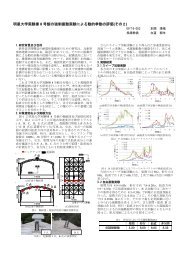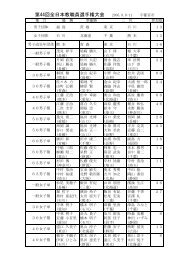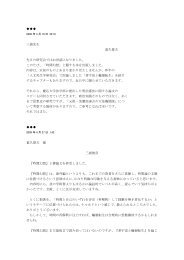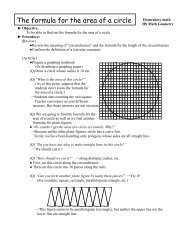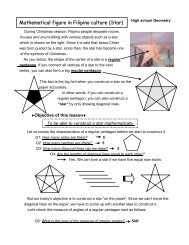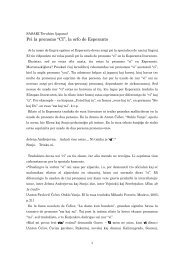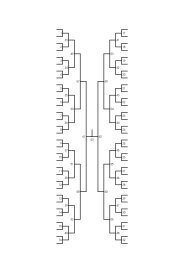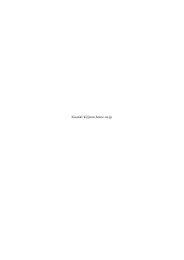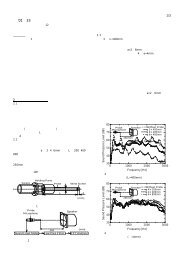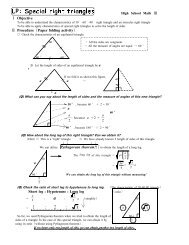Classification of solids - home.ne.jp
Classification of solids - home.ne.jp
Classification of solids - home.ne.jp
You also want an ePaper? Increase the reach of your titles
YUMPU automatically turns print PDFs into web optimized ePapers that Google loves.
1. The formula for the volume <strong>of</strong> a rectangular prism<br />
◎ Square<br />
( rectangle)<br />
Math elementary<br />
If you use short paper, the lengths<br />
<strong>of</strong> sides are 8.5 inches( 21.5 cm) .<br />
◎ Cube<br />
( square)<br />
( fold and open) ( fold and open) ( fold)<br />
( fold) ( fold) ( open)<br />
( fold) ( back side also) ( fold)<br />
( back side also) ( fold and insert) ( fold and open)<br />
( blow )<br />
If you use short paper, the lengths<br />
<strong>of</strong> sides are 2.1 inches( 5.4 cm) .
( Example <strong>of</strong> PWA )★ How to derive the formula for the volume <strong>of</strong> a rectangular prism ★<br />
Thevolume<strong>of</strong>afigureistheamount<strong>of</strong>space<br />
inside the figure 1<br />
← 1<br />
Volume is measured using cubic units.<br />
We are going to use the cube which we made by 1 1<br />
paper folding.<br />
☆ LET'S TRY TO FIND OUT THE FORMULA FOR THE VOLUME OF A RECTANGULAR PRISM ! ☆<br />
< ACTIVITY><br />
● Objective ●<br />
To be able to understand the formula for the volume <strong>of</strong> a rectangular prism<br />
● Procedure ( group activity)<br />
●<br />
1. Make several groups ( 5 ~ 6 pupils for each group ).<br />
2. Each group makes 24 cubes by folding paper.<br />
3. Work in a group<br />
( Q)<br />
Let those cubes be cubic unit.<br />
Form rectangular prism using 24 cubicunitsasmanyaspossible.<br />
24=2 × 2 × 2 × 3 ( Prime Factorization)<br />
↓<br />
We can form following rectangular prisms.<br />
1 24=1 × 1 × 24<br />
1<br />
2 24=1 × 2 × 12<br />
3 24=1 × 3 × 8<br />
2 5<br />
4 24=2 × 2 × 6<br />
4<br />
5 24=2 × 3 × 4<br />
3<br />
v<br />
4. Each group present their ideas.<br />
5. Make the formula for the volume <strong>of</strong> a rectangular prism.<br />
Since we use 24 cubic units, the volume <strong>of</strong> these rectangular prisms is all 24.<br />
On the other hand, can we get the number this volume "24" by computation? not by counting.<br />
Which number do you use in the <strong>solids</strong>? Is there a common rule in order to get the number 24<br />
by computation?<br />
The number <strong>of</strong> cubic units we arranged lengthways<br />
× The number <strong>of</strong> cubic units we arranged widthways<br />
× The number <strong>of</strong> cubic units we piled<br />
↓<br />
We can find out the following formula.<br />
Volume <strong>of</strong> a rectangular prism = length × width × height<br />
6. ( Exercise)<br />
Find the volume <strong>of</strong> each figure<br />
1 2 3<br />
8 cm<br />
5 cm<br />
8 cm 8 cm 7 cm<br />
8 cm 12cm 6 cm<br />
5<br />
cm
2. <strong>Classification</strong> <strong>of</strong> <strong>solids</strong><br />
◎ Regular hexagon<br />
( rectangle)<br />
open side<br />
crease<br />
◎ Regular Tetrahedron<br />
valley folded li<strong>ne</strong>s ( turn it over)<br />
valley folded li<strong>ne</strong>s<br />
insert<br />
fold and open<br />
blow
( Example <strong>of</strong> PWA ) ★ <strong>Classification</strong> <strong>of</strong> <strong>solids</strong> ★<br />
There are plenty <strong>of</strong> ways <strong>of</strong> observing a solid. If we have several <strong>solids</strong> ( as shown in the figure<br />
below ), there would be various ways <strong>of</strong> observing, for example "How many surfaces are there?", "What<br />
shapes <strong>of</strong> surface does this solid have ?", "if we project it to the wall, what shape can we see?" and so on.<br />
Concrete materials enable pupils to make sure the<br />
characteristics <strong>of</strong> <strong>solids</strong>.<br />
On the other hand, textbooks has these kinds <strong>of</strong> questions:<br />
A<br />
B<br />
D<br />
"Is this figure a prism or a pyramid?" "Which solid is a cylinder?"<br />
C<br />
In these questions pupils only find the answer. It's nothing<br />
more than a knowledge. We can't state it's a comprehension.<br />
The most important thing for math teachers is to make<br />
E<br />
F<br />
pupils find out <strong>ne</strong>w concept and characteristics by themselves.<br />
G<br />
H<br />
If we give this question "which <strong>solids</strong> belong to the samegroupassolidH?",pupilscoulddecidethe<br />
perspective by themselves and could start classifying <strong>solids</strong>. ( We call this kind <strong>of</strong> questions<br />
"Open-ended question".)<br />
< ACTIVITY><br />
● Objective ●<br />
To be able to classify <strong>solids</strong> by observing its characteristics<br />
● Procedure ●<br />
1. Pupils make Cube and Regular Tetrahedron by folding paper.<br />
2. ( Q)<br />
What is the common denominator, what is the difference between two <strong>solids</strong>?<br />
( difference) ( common denominator)<br />
・number <strong>of</strong> surface<br />
・closed solid<br />
・figure <strong>of</strong> surface<br />
・number <strong>of</strong> surface gathering round a vertex<br />
・number <strong>of</strong> vertex<br />
・every surface is pla<strong>ne</strong> figure<br />
・ parallel li<strong>ne</strong>s etc.<br />
etc.<br />
○ We may say that these two <strong>solids</strong> belong to the same group in terms <strong>of</strong> closed figure.<br />
× However, we can't state that these two <strong>solids</strong> belong to the same group in terms <strong>of</strong> number <strong>of</strong><br />
surface.<br />
( If there in not enough time, resume 3 in <strong>ne</strong>xt lesson. )<br />
3. Work in a group ( group activity)<br />
A<br />
B<br />
( Q)<br />
Thereare8<strong>solids</strong>.Checkthe<strong>solids</strong>whose<br />
C<br />
D<br />
characteristics is the same as F. Also, write<br />
its characteristics.<br />
E<br />
F<br />
G<br />
H<br />
Characteristics A B C D E F G H<br />
( example) pyramid solid<br />
∨ ∨<br />
( example) base figure is quadrilateral<br />
∨ ∨ ∨<br />
4. Each group presents their ideas.<br />
( Weca<strong>ne</strong>xpectplenty<strong>of</strong>ideas.Wejustcheckwhetheritiscorrectornot. )<br />
Open-ended !!<br />
5. Give an assignment<br />
( Q)<br />
In above question, check the <strong>solids</strong> whose characteristics is the same as E.<br />
Also, write its characteristics. ( Pupils make a list as well as 3. )<br />
Ate<strong>ne</strong>o De Davao University - Regional Science Teaching Center
Activity Sheet( <strong>Classification</strong> <strong>of</strong> solid)<br />
A<br />
B<br />
C<br />
D<br />
( Hints)<br />
・ figure <strong>of</strong> surface<br />
・ vertex, side, the number <strong>of</strong> surface<br />
・ parallel, perpendicular li<strong>ne</strong> and face<br />
・ volume and area <strong>of</strong> surface<br />
etc<br />
E<br />
F<br />
G<br />
H<br />
( Q)<br />
Compare solid F with another <strong>solids</strong><br />
Characteristics A B C D E F G H<br />
( example) pyramid solid<br />
∨ ∨<br />
( example) base figure is quadrilateral<br />
∨ ∨ ∨<br />
( Assignment)<br />
Compare solid E with another <strong>solids</strong><br />
Characteristics A B C D E F G H
Can you visualize <strong>solids</strong>?<br />
→ If you understand the characteristics <strong>of</strong> <strong>solids</strong>, you could draw them easily.<br />
cube<br />
rectangular prism<br />
sphere<br />
cylinder<br />
pentagonal prism pyramid ( quadrangular pyramid)<br />
triangular pyramid<br />
co<strong>ne</strong>



